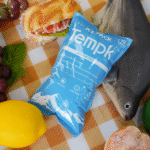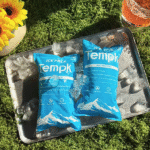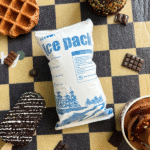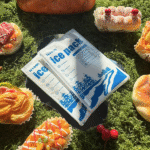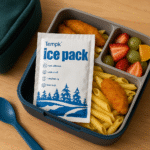Trockeneisbock: 2025 Kauf, Lagerung & Versandhandbuch
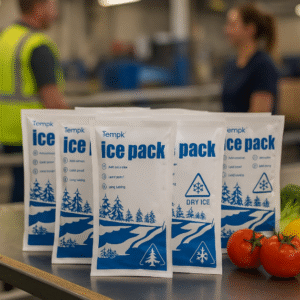
Auf einen Blick – was Sie lernen werden
-
Welche „Trockeneispackungen“ enthalten eine Masse? bedeutet (Und was es nicht tut).
-
Wie Wählen Sie Pellets vs. Blöcke und das Recht Isolierter Behälter.
-
A Schneller Schätzer wie viel Trockeneis geladen werden soll.
-
Das genaue 2025 Etiketten & Papierkram die die Abnahmeprüfung bestehen.
-
Sicherheitsgrenzen für CO₂ und die richtige Art der Speicherung/Entlüftung.
1‑Satzdefinition (Bereit für den vorgestellten Snippet):
Trockeneis-Packungen in großen Mengen bezieht sich auf Paletten-/Behälter- oder Kartonmengen an festem CO₂ (Pellets/Blöcke) Lieferung in belüfteten Linern und Verwendung mit Isolierung, Verlader entlüften; Kästchen müssen gekennzeichnet sein „Trockeneis“/„Kohlendioxid“., solide,”Und 1845, und Netto-Trockeneismasse (kg) gemäß den Luft-/Bodenregeln.
Was genau kaufst du??
Gemeinsame Formate
-
Pellets (≈3–16 mm): schnelles Herunterziehen, gleichmäßige Abdeckung.
-
Reis/Minipellets (≈⅛–¼″): dichte Packung um unregelmäßige Formen.
-
Blöcke/Laibe: langsamere Sublimation, längere Haltezeiten mit weniger Öffnungen.
(Wählen Sie nach Bahnlänge und Öffnungshäufigkeit.)
Isolierte Behälter
-
EPS (Budget, 24–48H)
-
EVP (robust/wiederverwendbar, 36–72H)
-
VIP-Hybriden (längster Halt, 48–96h+)– Ermöglicht oft eine Reduzierung der Trockeneismasse und des DIM-Gewichts aufgrund der viel geringeren Wärmeleckage. (VIPs bieten eine extrem niedrige Leitfähigkeit; Modellkosten vs. Kältemitteleinsparungen.)
Wie viel Trockeneis brauchen Sie?
Zwei Ground-Truth-Raten aus FAA-Tests werden häufig für die Planung verwendet:
-
Kleine Pakete (~5 Pfund): ~2 % der Masse pro Stunde
-
Groß/eng verpackt (~100 Pfund): ~1 % pro Stunde
Auch, 1 Pfund Trockeneis → ~8,8ft³ CO₂-Gas (Belüftung planen).
Schneller Schätzer (Verknüpfung des Planers)
Bevorzugen Sie metrische Werte? 1 Pfund ≈ 0,454 kg.
Gegenprobe der Physik: Trockeneis absorbiert ~25–27kJ/mol bei Sublimation (≈571–615 kJ/kg); Ihre Lane-Berechnung sollte angesichts dieses Energiebudgets sinnvoll sein.
(Der Schätzer und die Planungsbereiche konsolidieren die von Ihnen entworfenen Rechner, verschärft durch FAA/NIST-Daten.)
Startertisch (mit 25% Verzögerungspuffer)
| Kasten (inneres L) | Container | Transit (H) | Ost . Trockeneis (kg) | Notizen |
|---|---|---|---|---|
| 22 L | EPS 30 mm | 24–36 | 3.5–5,0 | Kopfraum minimieren |
| 30 L | EPP 40mm | 36–48 | 5.0–7,0 | Hinzufügen 25% Im Sommer |
| 45 L | VIP Hybrid | 48–72 | 6.5–10,0 | Weniger Eis, höhere Kartonskosten |
Pellets vs. Blöcke: was länger hält?
-
Pellets Gleichmäßig verteilen und die Temperatur schnell senken → am besten für gemischte Artikel & häufiges Türöffnen.
-
Blöcke/Laibe haben ein geringeres Oberflächen-Volumen-Verhältnis → langsamere Sublimation und längere Haltezeiten; Ideal für lange Gassen mit minimaler Öffnung.
(Beides vermischen: Blöcke für Grundlast + Pellet-„Rand“ in der Nähe heißer Stellen.)
Compliance, die eingeht 2025 (Luft & Boden)
Auf dem Paket (Luft):
-
Richtiger Versandname "Trockeneis" oder „Kohlendioxid, solide"
-
Und 1845
-
Nettomasse von Trockeneis in Kilogramm
-
Klasse 9 Etikett (Keine Schrift im Inneren des Diamanten)
Verwenden Sie das 2025 Iata Trockeneis Akzeptanz -Checkliste; Es standardisiert, was Bodenpersonal überprüft.
Auf dem Frachtbrief: inklusive Trockeneiseintritt Pakete × netto kg; Einige Betreiber verlangen Nettogewicht Bei der Buchung um Flugzeuggrenzen zu überprüfen (66th Ed. Nachtrag).
UNS. Boden (PUNKT): Die Verpackung muss eine CO₂-Freisetzung ermöglichen; Modi haben bestimmte Markierungen (Z.B., Schiffswarnungen). Sehen 49 CFR§173.217.
USPS (Inländische Luftpost): ≤5lb (≈2,27 kg) pro Poststück, keine internationale Trockeneispost; Befolgen Sie die Verpackungsanweisungen 9A.
Für die Spitze: Drucken Sie Etiketten mit UN1845 und Netto-kg auf die gleiche Seite wie das Gefahrenetikett, wenn der Platz es zulässt – die Spediteure übernehmen dies 2025 Jobhilfen.
Sichere Aufbewahrung & Handhabung (Menschen und Räume)
-
Niemals luftdicht. Belüftete Kühler/Auskleidungen verwenden; Tun nicht Kleben Sie die inneren Schaumstoffdeckel zu.
-
Aufenthaltsbereiche belüften—CO₂ sinkt tief; Erwägen Sie Bodenmonitore in großen Mengen.
-
Handschuhe + Augenschutz um Kälteverbrennungen zu vermeiden.
-
Beachten Sie die Arbeitsplatzgrenzwerte für CO₂: TWA 5.000 ppm Und Stel 30.000 ppm (NIOSH/OSHA).
Containerkommissionierung (Kaufen Sie die Box vor dem Eis)
| Container | Beste Spur | Eiseinschlag | Wann zu wählen |
|---|---|---|---|
| EPS (25–40mm) | 24–48H | Höhere Gebühr | Budget beginnt |
| EVP (30–50mm) | 36–72H | Mäßige Ladung | Wiederverwendung/Haltbarkeit |
| VIP Hybrid | 48–96h+ | Niedrigste Gebühr | Lange/heiße Fahrspuren; DIM schneiden |
VIPs reduzieren aufgrund der extrem niedrigen Wärmeleitfähigkeit häufig die Kältemittelmasse für Routen von 72 bis 144 Stunden. (Validierung mit Datenloggern.)
Kauf in großen Mengen (ohne Überraschungen)
-
Lieferform: Behälter/Behälter (~200–1.400 Pfund) oder palettierte Kisten; Legen Sie wiederkehrende Drops fest und ordnen Sie Auslöser neu an.
-
Lieferanten-Scorecard: Klasse/Spez (SDS, Pelletdurchmesser/Blockgröße), Versorgungssicherheit, Verpackung (belüftete Einlagen), und Compliance-Unterstützung (Musteretiketten).
-
Kostenkontrolle: Verkleinern Sie den Kopfraum → legen Sie Eis darauf → verbessern Sie die Isolierung, bevor Sie mehr Eis hinzufügen; VIP kann die Gesamtlandekosten senken, wenn die Fahrspuren lang sind.
Häufig gestellte Fragen
Q1: Sind „Trockeneis-Packs“ dasselbe wie Gel-/PCM-Packs??
NEIN. Trockeneis ist festes CO₂ (~ −78,5 °C) für gefroren Gassen; Gele/PCMs Ziel gekühlt Temperaturen und sind kein Ersatz für UN1845-Trockeneis.
Q2: Wie viel Trockeneis pro Tag sollte ich planen?
Verwenden ~1–2 %/h Massenverlust als Ausgangspunkt (FAA), Dann hinzufügen 25–50% Puffer für Verzögerungen und Öffnungen. Vergleichen Sie es mit dem Sublimationsenergiebudget.
Q3: Was muss für Luft auf der Box sein??
„Trockeneis“/„Kohlendioxid“., solide", Und 1845, Netz kg, Und Klasse 9– plus AWB-Text. Nutzen Sie die IATA 2025 Checkliste.
Q4: USPS-Grenzwerte für Trockeneis?
Inländisch Luft E-Mail ist auf begrenzt ≤5lb pro Poststück; Internationale Post mit Trockeneis ist verboten.
Q5: Ist es in Ordnung, die Innenauskleidung zu versiegeln, um die Kälte länger zu halten??
NEIN. Verpackung muss CO₂ Wind zum Verhindern des Druckbaus zu verhindern.
Anleitung: Packen Sie eine gefrorene Kiste mit Trockeneis in großen Mengen (20‑Minuten-SOP)
-
Versender zusammenbauen (EPS/EPP/VIP) und bestätigen Entlüftungswege.
-
Gepäckladung, fügen Sie a hinzu Starrer Teiler/Tablett zum Trennen vom Eis.
-
Trockeneis von oben laden über Produkt; Minimieren Sie den Kopfraum mit Einbauten.
-
Anwenden Und 1845, Klasse 9, Netz kg; verifizieren Awb Text.
















